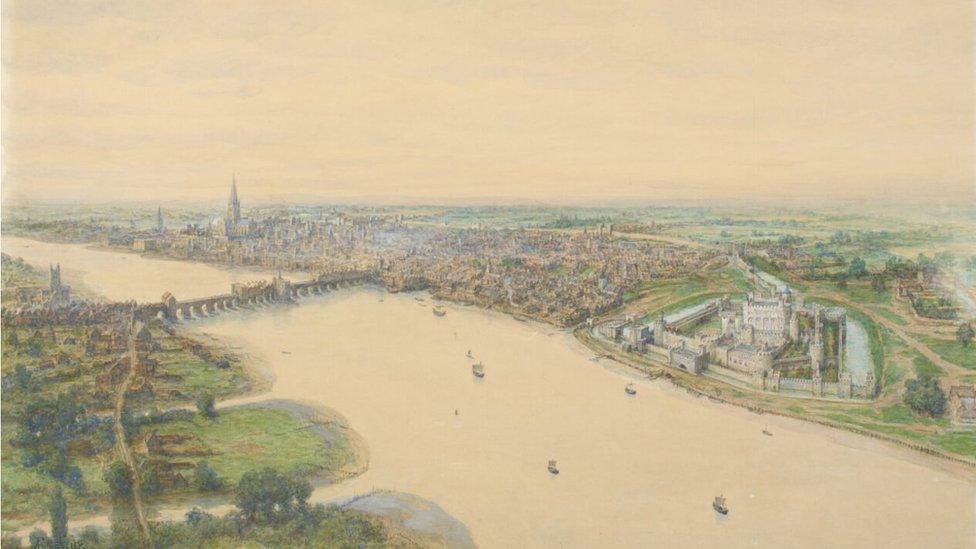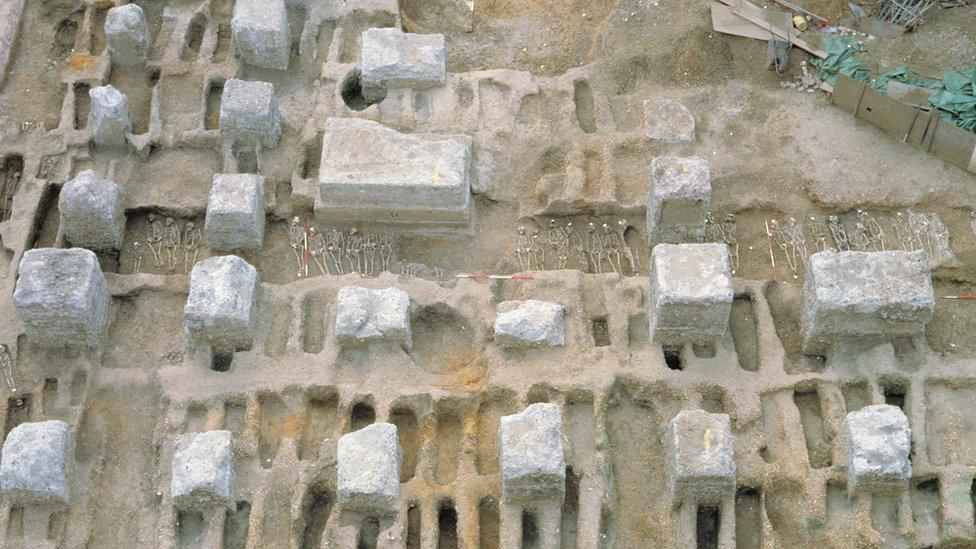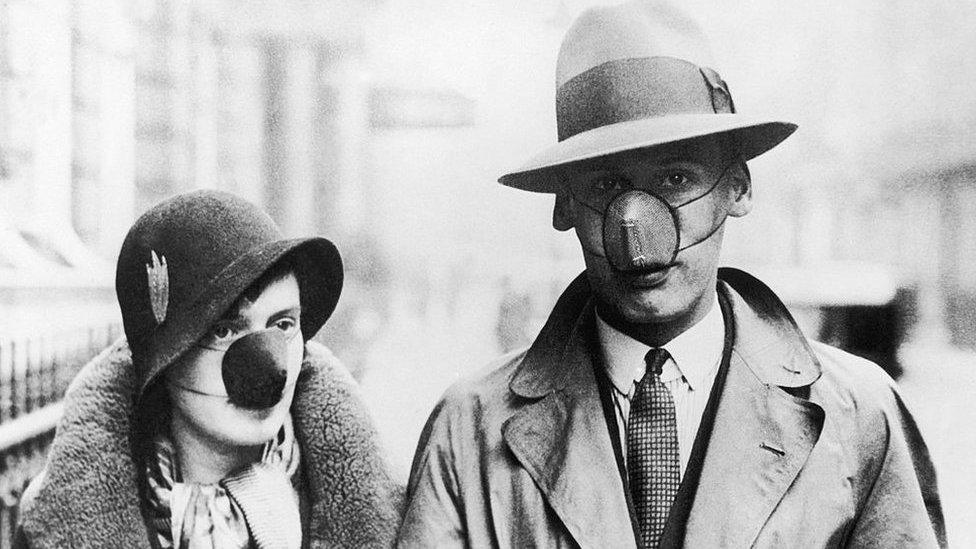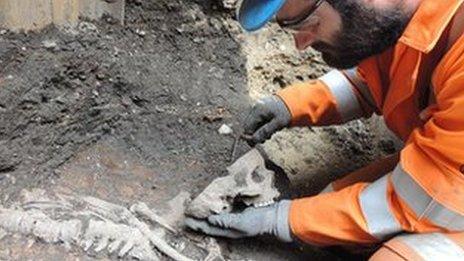Black women most likely to die in medieval plague, Museum of London says
- Published

London in 1400 by Amédée Forestier, a French artist who specialised in historical landscapes
Black women of African descent were more likely to die of the medieval plague in London, academics at the Museum of London have found.
The study is the first archaeological exploration of race, gender and social standing influencing a person's risk of death, during what was known as the Great Pestilence or Great Mortality.
The research is based on 145 individuals from three cemeteries.
The outbreak is believed to have claimed the lives of 35,000 Londoners.
The report, which has been peer-reviewed, is called Race, Population Affinity, and Mortality Risk during the Second Plague Pandemic in Fourteenth-Century London, England and is due to be published by Bioarchaeology International, external by the end of the year.
An advance copy of the paper was given to the BBC.
Data on bone and dental changes of the 145 individuals from East Smithfield emergency plague cemetery, St Mary Graces and St Mary Spital formed the basis of the study.
This primary data was then examined by applying a forensic anthropological toolkit to estimate whether the bones were likely to have come from someone with African heritage.
The report also acknowledges the sample size is small and that it has been careful to avoid what it termed as "the incorrect and harmful implication that there is a biological basis of race and we actively oppose the incorrect inference that there is something inherent to people assigned to a certain racial category that makes them more vulnerable to disease".
It goes on to state: "Instead, we emphasize here that variation by race in susceptibility to and hazard of dying from disease reflects the biological and psychosocial effects of racism, which was present in the medieval world (Heng 2018a); race is a social classification and is not based in biological reality, but it does have biological consequences."

Data from the East Smithfield plague burial site was used in the study
It found there were significantly higher proportions of people of colour and those of Black African descent in plague burials compared to non-plague burials.
The report said: "There is a significantly higher proportion of people of estimated African affiliation in the plague burials compared to the nonplague burials (18.4% vs. 8.3%).
"For the female-only sample, individuals of estimated African population affinity have a significantly higher estimated hazard of dying of plague compared to those with estimated white European affinity. There are no significant associations for any of the other comparisons."
The likelihood of dying from the Great Pestilence was highest amongst those who already faced significant hardship, including exposure to famines that hit England during this time.
The research concluded that higher death rates amongst people of colour and those of black African descent was a result of the "devastating effects" of "premodern structural racism" in the medieval world.

What was the medieval plague?
Often referred to today as the Black Death, the outbreak of 1348-1350 was a deadly infectious disease that swept across Asia and Europe, killing millions of people.
Modern scientific research has identified this as a plague pandemic but in the mid-1300s people had no idea what the disease was or how to stop it.
It arrived in London in the autumn of 1348 and lasted until the spring of 1350.
More than half the population of London died. Emergency cemeteries had to be set up to bury them.
The disease was carried by rats who had infected fleas, and also transmitted by droplet infection, such as people coughing on each other.
Symptoms included fever, fatigue, vomiting and buboes (large swellings).

Social and religious divisions based on origin, skin colour and appearance were present in both medieval England and Europe.
The paper said that from 1336 to 1584 "nearly 18,000 'foreigners' had come to London from India, Greece, Iceland, and mainland Europe".
While no population figures for black women in London have been recorded the paper added during this period mercantile and richer migrants who regularly stayed in London, accompanied by entire households, often had servants who were free or enslaved people originating from Sub-Saharan and northern Africa or Eastern Europe.
The research team added people of colour were established in the UK thousands of years and ago and this was reflected in literature and other sources.
Biological anthropologist from University of Colorado, Prof Sharon DeWitte, said: "Not only does this research add to our knowledge about the biosocial factors that affected risks of mortality during medieval plague epidemics, it also shows that there is a deep history of social marginalization shaping health and vulnerability to disease in human populations."
Associate professor of anthropology at Michigan State University, Dr Joseph Hefner, said: "This research takes the deep dive into previous thinking about population diversity in medieval England based on primary sources.
"Combining bioarchaeological method and theory with forensic anthropological methods permits a more nuanced analysis of this very important data."
Dr Rebecca Redfern, from the Museum of London, said: "We have no primary written sources from people of colour and those of black African descent during the Great Pestilence of the 14th Century, so archaeological research is essential to understanding more about their lives and experiences.
"As with the recent Covid-19 pandemic, social and economic environment played a significant role in people's health and this is most likely why we find more people of colour and those of black African descent in plague burials."
This story was updated on 24 November to provide additional context, such as the methodology used and considerations made about race and biology by the report authors, as well as information about black people living in London at the time and their social status, which were also referenced in the research paper. Direct quotes from the research authors were also added to the story, as well as the full name of the research paper and details of where it can be seen online once it is released to the public.

Listen to the best of BBC Radio London on Sounds and follow BBC London on Facebook, external, X, external and Instagram, external. Send your story ideas to hello.bbclondon@bbc.co.uk, external
Related topics
- Published22 February 2021

- Published18 December 2020

- Published9 February 2015
